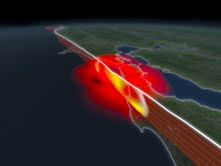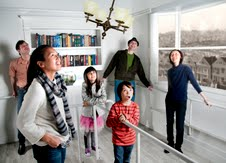
We're a little bit weird about earthquakes, aren't we? There will be a few hundred quakes in California this week and those of us who live here are not only blasé about small quakes, we can find them a little exciting. Little bit. Did you feel that? Where were you when it happened? Did the room sway? What was the magnitude? Where was the epicenter? What's in your earthquake kit?
Like a storm, majestic in its power -- it's all pretty awesome until some one gets hurt. So the sturdy ground of the California Academy of Sciences is a wonderful place to theoretically learn all about the science of earthquakes.
A new exhibit, "Earthquake: Life on a Dynamic Plane," opened at the California Academy of Sciences last weekend to help visitors understand the why? and wow? of plate tectonics and to let them experience the what the --? of seismic activity.

In conjunction, the Morrison Planetarium will premiere Earthquake: Evidence of a Restless Planet, the third of the Academy's award-winning digital productions.
The 30-minute show in the digital dome flies us over the San Andreas fault, dives into the planet's interior, and rewinds us to 1906 San Francisco earthquake and further back to 200 million years ago before the break-up of Pangaea, the Earth's supercontinent -- which was the conglomerate of all of the planet's land masses before earthquakes set the continents adrift.
"By showing visitors the science that underlies these natural events, we want to help visitors understand how the great movements of the continents have produced the landscape we call home today and the life around us."
So the show, narrated by Bay Area native, Benjamin Bratt, describes the intersection of geological time and human time. This is most excitingly shown when we observe the plates that shifted that caused the earth to move and the ground to crack in a wave that reached the ferry building clock tower and rolls up Market Street as houses fall, fires spread and horses flee.

This street-view recreation may actually be the coolest -- if not the most educational -- part of the production. At other times, we see continents drift via satellite map imagery and we see terrains mapped and a global road map of fault lines across a spinning earth, which looks much like Google Earth. It's not the wild virtual space travel that visitors experienced in A Fragile Planet, which took us light-years away. But it's an impressive view of sub-planetary commotion.
The edu-tainment rolls on in the Shake House, an earthquake simulator that is an updated version of one of the Academy's most popular past exhibits. Visitors enter the parlor of a Victorian House, with bookcases, chandeliers, a china cabinet and a view of painted ladies. And a railing to hold onto when they turn on the tremors. House guests first experience the 15-second, 6.9-magnitude Loma Prieta earthquake of 1989 (replete with sounds of the World Series in the background) and a 30-second versions of the 7.9-magnitude San Francisco quake of 1906. In fact, that quake lasted 90 seconds -- but we get the idea.
The exhibition continues with a view from inside the Earth, revealing the inner molten core and the outer core in 25-foot-diameter model of the Earth. There are interactive stations, touchable rocks and minerals and... baby ostriches! The squadron of newly hatched ostrich chicks are here to provide the cutest possible way to understand Continental drift. The ancestors of these flightless birds rafted atop floating landmasses and are scattered today in continents thousands of miles apart.
In the exhibition's Are You Prepared? nook, Californians can remind themselves of all the earthquake supplies they've been meaning to get. Learn about the dos and don'ts of post-earthquake etiquette: Can you drink your toilet water? (No.) Can you drink from your water heater? (Heck yes.) A computer game (soon to be online) has been made by high schoolers to help you pack your emergency back pack. If you drag the make up kit icon into your backpack icon, your are so totally not prepared.

The exhibit at the California Academy of Sciences, 55 Music Concourse Drive, Golden Gate Park, San Francisco, Calif.
All photos courtesy of the California Academy of Sciences.
